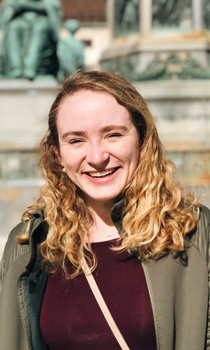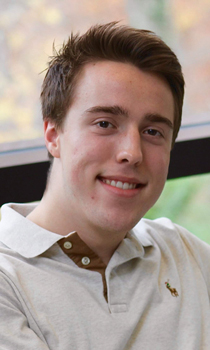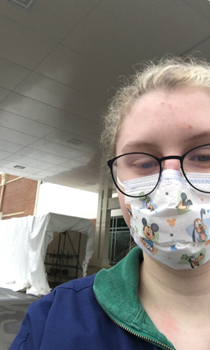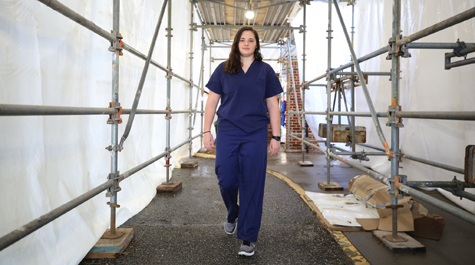W&M students stay to help fight pandemic in Williamsburg hospitals
The easy choice would have been to stay home in Richmond after spring break while the world battled a growing COVID-19 pandemic, but Gillian Gaunt ’21 had an important job waiting for her back in Williamsburg.
She was called back to serve on the front lines of the medical community during this trying time.
As a scribe at Sentara Williamsburg Regional Medical Center, Gaunt provides valuable assistance to emergency room physicians by tracking the providers’ interactions with patients and other medical staff and keeping copious records of those exchanges. 
“My first shift going back into the hospital after everything happened, I said to myself, ‘OK, this is the choice that I’ve made. I am not going home for the foreseeable future. I’m going to stay here and help in the smallest way possible,’” Gaunt said.
There’s no overstating the significance of Gaunt’s work and the work of several other William & Mary students who elected to return to Williamsburg to serve at area hospitals.
“These are some of our best people,” said Beverly Sher, a senior lecturer in chemistry who serves as W&M’s chief health professions advisor.
“I know I’ve had to delay assignments for some folks because what they’re doing is more important than class,” Sher continued. “They’re going to get the work in, but I think it’s important that they have the energy that they need to put that extra scribe shift in or do that extra EMT run or whatever it is. This is real life. It matters.”
For all of the students currently working in the medical profession, the COVID-19 pandemic has been a challenging yet valuable experience that could help them as they continue on tracks they hope will lead to full-time careers in the medical field.
“I’m seeing the sacrifices the physicians, nurses and the scribes are having to make, and I think choosing to continue with it sets the tone for my career in medicine,” Gaunt said. “I am willing to do this now when I don’t really have any stake in it, but this is important to me.”
‘OK, it’s here. This is really happening.’
When patients come into the emergency room at Sentara Williamsburg Regional Medical Center, their names and medical status go up on a tracking board.
Jonah Finkel ’20, a scribe at Sentara, did a double take when he saw the words “Suspect COVID” on the board for the first time.
“It was sobering and definitely scary, like, ‘OK, it’s here. This is really happening. It’s right here where I’m living.’” 
Finkel’s job used to require working alongside medical providers in examination rooms, but that changed soon after the first COVID-19 cases were confirmed in the area.
Sentara went to a tele-scribing method in which scribes keep notes from separate rooms as providers tend to patients. The information is documented by listening to the doctor-patient interactions via iPad tablets.
Recently, Sentara has allowed Finkel and other scribes to work from home. The tele-scribing process might be effective, but Finkel says it is no substitute for doing the work in person.
“This all has shown me the unspoken power of human connection,” Finkel said.
Area emergency rooms understandably saw a spike in patients during the first days of COVID-19 in the area. Any of the symptoms associated with the virus — fever, cough, shortness of breath — often led worried persons to the ER to get checked out.
But those with mild symptoms were sent home because of a shortage of tests.
Ali Crawford ’20, who works as an EMT at Riverside Doctors’ Hospital in Williamsburg, said in those first days patients were only admitted if they had breathing problems, were older or met other criteria that put them at risk.
Others were sent home and told to come back if any serious complications arose.
That didn’t stop some from calling in a panic thinking they contracted COVID-19. Crawford said one patient checked his temperature every 10 minutes and called when it deviated by a fraction of a degree.
“It was a lot to deal with because we were so busy with all the patients coming in, and then we had to deal with people calling us for things like that,” Crawford said.
‘Definitely a sense of panic and scare’
Rachel Akers ’21, a scribe at both Riverside hospitals in Williamsburg and Newport News, knows a physician in Newport News who was exposed to COVID-19 in March and was quarantined away from her husband and children for 14 days.
“That was such a struggle for her, coming home and not being able to hug her kids or having to keep them away from her, and they’re young and don’t really understand what the virus is and why it’s such a danger,” Akers said. 
“I think that really made me realize how serious of an issue this was and how my work helps with physician burnout so that they can go home and decompress and they don’t have to worry about charting as much,” Akers continued. “That’s when I really thought that I should keep doing what I’m doing, and quitting wasn’t an option for me monetarily.”
The early cases of COVID-19 made for some tense environments in area hospitals.
“There was definitely a sense of panic and scare,” Akers said.
Akers still accompanies doctors for some exams while wearing a surgical mask. At other times, she scribes from a separate room.
Before COVID-19, Akers worked three to four shifts a week scribing at Riverside Doctors’ Hospital in Williamsburg. During the pandemic, she added shifts at Riverside’s facility in Newport News and now works five days a week.
Her workload comes with some big sacrifices, not the least of which is being away from her parents in northern Virginia. Sometimes FaceTime calls aren’t enough to cure her homesickness, but her job is important to her and she finds a way to make it work.
“My dad’s 60th birthday was April 21st, but I wasn’t able to be around because I didn’t want him to get sick,” Akers said.
Being away from home is hard for Crawford, too. Easter is a big time for her family back home in the Roanoke area. It was tough for her to miss that time with her loved ones.
Crawford is compelled to serve, particularly in areas where medical attention is scarce. She started out as a volunteer firefighter at 16 before being certified as an EMT, and she went on a medical mission trip to El Salvador.
Crawford works the night shift four days a week. Recently, she worked consecutive 60-hour weeks, splitting time between working in an area cordoned off for COVID-19 patients while also assisting with other emergency situations.
“It’s all I know,” she said. “It’s something that’s always been a calling.”
‘A better grip on it now’
It’s much quieter in area emergency rooms these days. COVID-19 is still a major threat, but social distancing measures combined with a better understanding of testing and treatment methods have lowered the number of panicked patients pouring into hospitals.
“We still have a lot going on, but I think there’s a better grip on it now,” Gaunt said.
The prospect of contracting the virus has kept patients with non-life threatening ailments out of the emergency room as well.
“I think people are starting to realize if they don’t have it and freak out and go to the hospital, the likelihood of them getting it is so much higher,” Crawford said. “People are finally starting to put it together.”
The medical staffs at area hospitals have rallied around each other to provide support while they do this difficult work.
Crawford said workers at Riverside Doctors’ Hospital periodically write inspirational messages on the hospital’s exterior brick walls, and the community has donated food and masks as a show of support.
Akers said a GoFundMe page was set up by one of the volunteer coordinators at Riverside to help pay local restaurants to deliver food to the emergency department.
Many people, including W&M students, are sacrificing time and resources to help during this difficult time.
“I think William & Mary has always been a school known for work ethic and community trust, and that’s really coming out more in this pandemic,” Akers said.
 Skip to main content
Skip to main content

